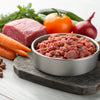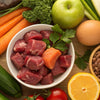Do You Have to Cook Raw Dog Food? Understanding the Essentials for Pet Nutrition
- Houndsy
Table of Contents
- Introduction
- Understanding Raw Dog Food Diets
- The Cooking Conundrum: Should You Cook Raw Dog Food?
- Different Methods of Cooking Raw Dog Food
- What About Food Safety?
- Cooking vs. Raw: Making the Right Decision
- Conclusion
Introduction
Imagine the struggle of wondering what to feed our furry friends. With so many options available—raw, cooked, dry, and wet—deciding on the right diet for our dogs can feel overwhelming. Did you know that recent surveys suggest that more than 50% of pet owners are considering fresh food diets for their pets? This significant shift stems from a growing awareness of the importance of nutrition and its impact on our dogs’ health. Given the turmoil surrounding pet diets, one often-asked question is, do you have to cook raw dog food?
In this blog post, we aim to clarify the intricacies of feeding our dogs, specifically regarding raw and cooked dog food. We will discuss the pros and cons of each diet type, delve into food safety, and explore how cooking can enhance some nutritional aspects while possibly hindering others. Our goal is to help you navigate this topic and reflect on your own pet feeding routine, taking into account what aligns best with your dog's health needs.
By the end of this article, you’ll gain a comprehensive understanding of raw dog food diets, whether you should consider cooking them, and the best practices for providing a balanced and safe diet for your canine companion.
Understanding Raw Dog Food Diets
Raw dog food diets, often referred to as BARF (Biologically Appropriate Raw Food), typically encompass uncooked meat, bones, organs, and some fruits or vegetables. The fundamental belief behind this diet is to mimic the natural feeding habits of dogs’ ancestors, which is appealing to many pet parents looking to optimize their dog's health.
Nutritional Benefits of Raw Diets
-
Nutrient Retention: Raw food is unprocessed and maintains its natural nutritional profile, including vitamins, enzymes, and minerals that can be diminished by cooking.
-
Biologically Appropriate: This diet mirrors what dogs would naturally consume in the wild, aligning more closely with their biological and evolutionary needs.
-
Digestive Support: The enzymes present in raw food can aid digestion, potentially decreasing the reliance on the dog's pancreas to produce extra digestive enzymes.
Potential Risks of Raw Diets
However, feeding raw is not without challenges:
- Nutritional Imbalance: Creating a balanced raw diet is complex; if not done correctly, it can lead to deficiencies in essential nutrients.
- Pathogen Concerns: Raw diets may harbor harmful bacteria (like Salmonella and E. coli) which could pose health risks to both pets and humans. According to the U.S. Centers for Disease Control and Prevention (CDC), ensuring proper handling and hygiene during meal prep is crucial when feeding raw diets.
The Cooking Conundrum: Should You Cook Raw Dog Food?
The question of whether you should cook raw dog food can be boiled down to individual circumstances, specifically your dog’s specific health needs and your ability to provide a balanced raw diet.
Advantages of Cooking Raw Dog Food
-
Pathogen Mitigation: Cooking can significantly reduce the risk of harmful bacteria. If a pet parent is concerned about foodborne illnesses, cooking the food to a safe temperature (typically 165°F) can add peace of mind.
-
Enhanced Palatability: For picky eaters, cooked food often presents a more enticing aroma and flavor, making it easier for them to accept their meals.
-
Easier Digestion for Some Dogs: Certain dogs, particularly those with sensitive stomachs or digestive issues, may do better on lightly cooked diets since cooking can break down some proteins, making them more digestible.
Disadvantages of Cooking Raw Dog Food
While cooking offers some benefits, there are drawbacks to consider:
-
Nutrient Loss: Cooking can reduce the availability of certain nutrients. For example, water-soluble vitamins can leech into cooking water, leading to potential deficiencies.
-
Denaturation of Proteins: High heat can alter the structure of proteins, which may hinder their digestibility and bioavailability.
According to experts, cooking at lower temperatures for shorter durations can help mitigate nutrient loss, but always requires careful consideration of cooking methods to ensure the food remains nutritious.
Different Methods of Cooking Raw Dog Food
If you decide to cook raw dog food, there are various methods you can employ:
-
Sautéing: This method uses a small amount of water or broth, cooking the food on low heat for a few minutes. This gentle method helps retain moisture and enhances flavors while limiting nutrient loss.
-
Slow Cooking: Utilizing a Crock-Pot or slow cooker can be an excellent way to prepare larger batches of food without significant nutrient degradation. Setting the cooker on low for several hours allows flavors to meld while maintaining a soft consistency.
-
Microwaving: Although a quick solution, microwave cooking may lead to uneven heating. If this method is used, it's crucial to check that the food reaches safe temperatures and that it's thoroughly mixed post-cooking.
Important Considerations When Cooking Raw Dog Food
-
Retain Cooking Juices: Always keep any liquid released during cooking as it contains water-soluble vitamins and may enhance your dog's meal.
-
Balance Nutrients: If you cook your dog’s food, you may need to supplement their diet with essential vitamins and probiotics that can be lost during cooking.
-
Consult a Professional: Whenever exploring home-cooked diets for dogs, it’s wise to consult with a veterinarian or a certified pet nutritionist to ensure nutritional adequacy.
What About Food Safety?
When contemplating whether to cook dog food, food safety is a primary concern. Proper handling and preparation are paramount in preventing bacterial contamination. Here are essential precautions to consider:
-
Use Safe Ingredients: Always purchase high-quality meats that are USDA-certified for human consumption. This ensures you’re providing the best and safest options for your pup.
-
Maintain Cleanliness: Clean surfaces, utensils, and hands thoroughly to reduce cross-contamination risks.
-
Store Correctly: If using raw ingredients, they should be frozen or refrigerated promptly to avoid spoilage.
Cooking vs. Raw: Making the Right Decision
When it comes down to the decision of whether or not to cook raw dog food, factors such as your dog’s health condition, preferences, and the complexity of preparing balanced meals should be evaluated.
For many healthy dogs, a raw diet that is formulated correctly could provide optimal nutrition and health benefits. However, older dogs, those with sensitive digestive systems, or those with specific health issues may benefit from lightly cooked food to ease digestion while still providing nutritious meals.
Listening to Your Dog
An essential aspect of feeding our dogs is recognizing their unique needs and preferences. Consider these reflective questions as you weigh your options:
- Is my dog thriving on their current diet?
- Does my dog show any aversion to raw food?
- What are my capabilities in terms of properly preparing a balanced raw diet?
Answering these questions can help you determine the most suitable feeding approach for your dog.
Conclusion
Navigating the complex world of dog nutrition can indeed feel daunting, but understanding the pros and cons of raw and cooked dog food is a significant step in the right direction. While cooking raw dog food is not strictly necessary, it can provide benefits depending on your dog's individual needs.
Ultimately, we want our dogs to lead healthy, vibrant lives. Prioritizing fresh, whole foods—whether raw or lightly cooked—is part of giving them the best nutrition possible. If you’re seeking an easy, consistent way to ensure your dog is well-fed with a beautifully designed solution, we encourage you to explore our flagship Houndsy Kibble Dispenser. It offers the convenience and precision needed for the daily feeding ritual.
In the end, the most important thing is that our pups enjoy their meals and that those meals contribute positively to their overall well-being.
FAQ
Do I have to cook raw dog food? No, cooking raw dog food is not necessary, but it depends on your dog's individual needs and preferences.
What are the benefits of feeding raw food to dogs? Raw food retains more nutrients, mimics a natural diet, and can support digestion through natural enzymes.
Can cooking raw dog food improve safety? Yes, cooking can reduce the risk of harmful bacteria that may be present in raw food, but it can also lead to nutrient loss.
How can I balance a raw dog food diet? It's best to consult with a veterinarian or pet nutritionist to ensure balanced nutrient considerations when formulating a raw diet.
What are some safe methods for cooking dog food? Gentle methods like sautéing or slow cooking can preserve nutrients while ensuring food safety.
Explore the benefits of the Houndsy Kibble Dispenser today—it's designed to enhance your dog feeding routine and elevate your dog's mealtime experience. Order Now!













